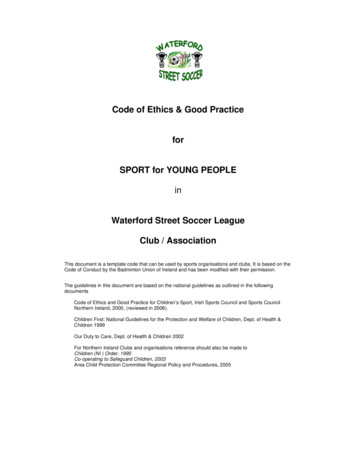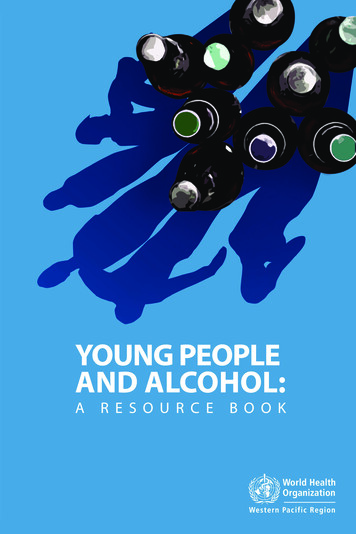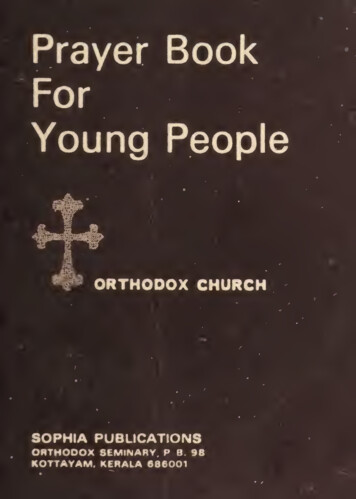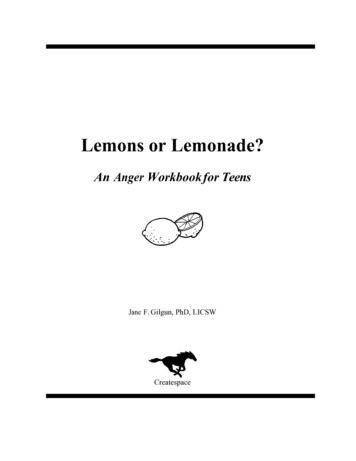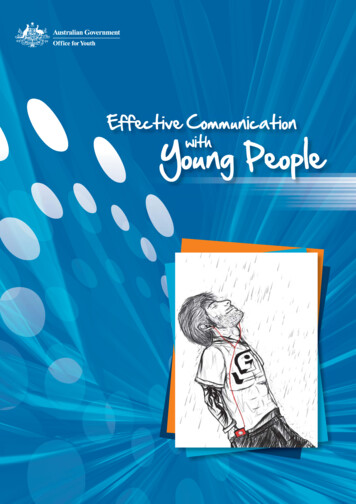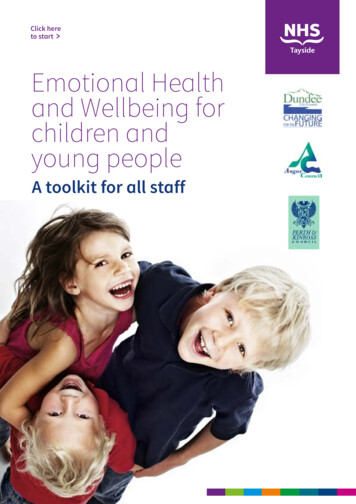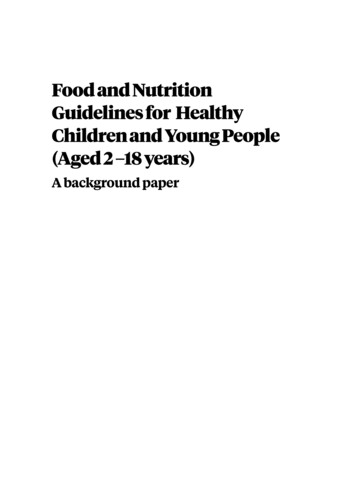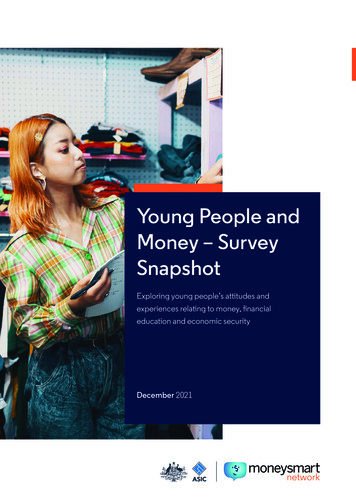
Transcription
Working with Young People withAutism Spectrum Disorder andComorbid Mental Disorders
Working with Young Peoplewith Autism Spectrum Disorderand Comorbid Mental DisordersPrimary Writers:Bethany AngusKatherine MonsonOther Contributors:Mary FlemingRachel GrantClare KentmannJessica Mitchell
2014. This work is copyright. Apart from any use permitted under the Copyright Act 1968, no part may be reproduced byany process, nor may any other exclusive right be exercised, without the permission of Melbourne Health ABN 73 802 706 972,300 Grattan Street, Parkville, Victoria 3050.ISBN: 978-1-920718-50-3Disclaimer:This information is provided for general educational and information purposes only. It is current as at the date of publication andis intended to be relevant for Victoria, Australia and may not be applicable in other jurisdictions. Any diagnosis and/or treatmentdecisions in respect of an individual patient should be made based on your professional investigations and opinions in the contextof the clinical circumstances of the patient. To the extent permitted by law, Orygen Youth Health Clinical Program will not beliable for any loss or damage arising from your use of or reliance on this information. You rely on your own professional skill andjudgement in conducting your own health care practice.iiWorking with Young People with Autism Spectrum Disorderand Comorbid Mental Disorders
Table of ContentsIntroduction . . . . . . . . . . . . . . . . . . . . . . . . . . . . . . . . . . . . . . . . . . . . . . . . . . . . . . . . . . . . . . . . . . . . . . . . . . . . . . . . . . . . . . . . . . . . . . . . . . . . . ivBackground . . . . . . . . . . . . . . . . . . . . . . . . . . . . . . . . . . . . . . . . . . . . . . . . . . . . . . . . . . . . . . . . . . . . . . . . . . . . . . . . . . . . . . . . . . . . . . . . . . . . . . ivThe Clinical need for this Manual . . . . . . . . . . . . . . . . . . . . . . . . . . . . . . . . . . . . . . . . . . . . . . . . . . . . . . . . . . . . . . . . . . . . . . . . . . . . . . . . . ivBackground to this Manual . . . . . . . . . . . . . . . . . . . . . . . . . . . . . . . . . . . . . . . . . . . . . . . . . . . . . . . . . . . . . . . . . . . . . . . . . . . . . . . . . . . . . . . ivProcess of Manual Development . . . . . . . . . . . . . . . . . . . . . . . . . . . . . . . . . . . . . . . . . . . . . . . . . . . . . . . . . . . . . . . . . . . . . . . . . . . . . . . . . ivHow to Use this Manual . . . . . . . . . . . . . . . . . . . . . . . . . . . . . . . . . . . . . . . . . . . . . . . . . . . . . . . . . . . . . . . . . . . . . . . . . . . . . . . . . . . . . . . . . . .vPart 1 : Understanding Autism Spectrum Disorder1The Core Features of Autism Spectrum Disorder . . . . . . . . . . . . . . . . . . . . . . . . . . . . . . . . . . . . . . . . . . . . . . . . . . . . . . . . . . . . . . . . . . 1Underlying Cognitive Impairment . . . . . . . . . . . . . . . . . . . . . . . . . . . . . . . . . . . . . . . . . . . . . . . . . . . . . . . . . . . . . . . . . . . . . . . . . . . . . . . . 2Part 2: Engagement and Assessment5Assessment . . . . . . . . . . . . . . . . . . . . . . . . . . . . . . . . . . . . . . . . . . . . . . . . . . . . . . . . . . . . . . . . . . . . . . . . . . . . . . . . . . . . . . . . . . . . . . . . . . . . . . 5Engagement . . . . . . . . . . . . . . . . . . . . . . . . . . . . . . . . . . . . . . . . . . . . . . . . . . . . . . . . . . . . . . . . . . . . . . . . . . . . . . . . . . . . . . . . . . . . . . . . . . . . . 5Part 3: Formulation and Treatment Planning7Establishing a Support Team . . . . . . . . . . . . . . . . . . . . . . . . . . . . . . . . . . . . . . . . . . . . . . . . . . . . . . . . . . . . . . . . . . . . . . . . . . . . . . . . . . . . . 7Formulation. . . . . . . . . . . . . . . . . . . . . . . . . . . . . . . . . . . . . . . . . . . . . . . . . . . . . . . . . . . . . . . . . . . . . . . . . . . . . . . . . . . . . . . . . . . . . . . . . . . . . . 7Establishing Treatment Goals . . . . . . . . . . . . . . . . . . . . . . . . . . . . . . . . . . . . . . . . . . . . . . . . . . . . . . . . . . . . . . . . . . . . . . . . . . . . . . . . . . . . . 8Modifying Psychotherapy for Young People with ASD . . . . . . . . . . . . . . . . . . . . . . . . . . . . . . . . . . . . . . . . . . . . . . . . . . . . . . . . . . . . 8Group Interventions. . . . . . . . . . . . . . . . . . . . . . . . . . . . . . . . . . . . . . . . . . . . . . . . . . . . . . . . . . . . . . . . . . . . . . . . . . . . . . . . . . . . . . . . . . . . . 11Part 4: Interventions that Address Difficulties Associatedwith Autism Spectrum Disorders13Psychoeducation. . . . . . . . . . . . . . . . . . . . . . . . . . . . . . . . . . . . . . . . . . . . . . . . . . . . . . . . . . . . . . . . . . . . . . . . . . . . . . . . . . . . . . . . . . . . . . . . 13Affective Education . . . . . . . . . . . . . . . . . . . . . . . . . . . . . . . . . . . . . . . . . . . . . . . . . . . . . . . . . . . . . . . . . . . . . . . . . . . . . . . . . . . . . . . . . . . . . 13Emotion Management . . . . . . . . . . . . . . . . . . . . . . . . . . . . . . . . . . . . . . . . . . . . . . . . . . . . . . . . . . . . . . . . . . . . . . . . . . . . . . . . . . . . . . . . . . 14Dealing with Sensory Difficulties . . . . . . . . . . . . . . . . . . . . . . . . . . . . . . . . . . . . . . . . . . . . . . . . . . . . . . . . . . . . . . . . . . . . . . . . . . . . . . . . 14Developing Social Skills and Understanding . . . . . . . . . . . . . . . . . . . . . . . . . . . . . . . . . . . . . . . . . . . . . . . . . . . . . . . . . . . . . . . . . . . . . 16Sex, Intimacy and Romantic Relationships . . . . . . . . . . . . . . . . . . . . . . . . . . . . . . . . . . . . . . . . . . . . . . . . . . . . . . . . . . . . . . . . . . . . . . . 19Managing Social Anxiety . . . . . . . . . . . . . . . . . . . . . . . . . . . . . . . . . . . . . . . . . . . . . . . . . . . . . . . . . . . . . . . . . . . . . . . . . . . . . . . . . . . . . . . . 19Exploring Identity and Developing Self-Understanding . . . . . . . . . . . . . . . . . . . . . . . . . . . . . . . . . . . . . . . . . . . . . . . . . . . . . . . . . . 20Transition Planning. . . . . . . . . . . . . . . . . . . . . . . . . . . . . . . . . . . . . . . . . . . . . . . . . . . . . . . . . . . . . . . . . . . . . . . . . . . . . . . . . . . . . . . . . . . . . . 20Pharmacological Interventions . . . . . . . . . . . . . . . . . . . . . . . . . . . . . . . . . . . . . . . . . . . . . . . . . . . . . . . . . . . . . . . . . . . . . . . . . . . . . . . . . . 20Part 5: Tools for Clinical Work21Worksheet 1: Core Features of an ASD . . . . . . . . . . . . . . . . . . . . . . . . . . . . . . . . . . . . . . . . . . . . . . . . . . . . . . . . . . . . . . . . . . . . . . . . . . . 22Worksheet 2: Support Star. . . . . . . . . . . . . . . . . . . . . . . . . . . . . . . . . . . . . . . . . . . . . . . . . . . . . . . . . . . . . . . . . . . . . . . . . . . . . . . . . . . . . . . 25Worksheet 3: Feelings Chart . . . . . . . . . . . . . . . . . . . . . . . . . . . . . . . . . . . . . . . . . . . . . . . . . . . . . . . . . . . . . . . . . . . . . . . . . . . . . . . . . . . . . 28Worksheet 4: Thermometer. . . . . . . . . . . . . . . . . . . . . . . . . . . . . . . . . . . . . . . . . . . . . . . . . . . . . . . . . . . . . . . . . . . . . . . . . . . . . . . . . . . . . . 30Worksheet 5: My Body. . . . . . . . . . . . . . . . . . . . . . . . . . . . . . . . . . . . . . . . . . . . . . . . . . . . . . . . . . . . . . . . . . . . . . . . . . . . . . . . . . . . . . . . . . . 32Worksheet 6: Thoughts and Feelings. . . . . . . . . . . . . . . . . . . . . . . . . . . . . . . . . . . . . . . . . . . . . . . . . . . . . . . . . . . . . . . . . . . . . . . . . . . . . 34Worksheet 7: The Comfort Zone . . . . . . . . . . . . . . . . . . . . . . . . . . . . . . . . . . . . . . . . . . . . . . . . . . . . . . . . . . . . . . . . . . . . . . . . . . . . . . . . . 36Worksheet 8: My Sensory Preferences. . . . . . . . . . . . . . . . . . . . . . . . . . . . . . . . . . . . . . . . . . . . . . . . . . . . . . . . . . . . . . . . . . . . . . . . . . . . 38Worksheet 9 The Friendship Hierarchy . . . . . . . . . . . . . . . . . . . . . . . . . . . . . . . . . . . . . . . . . . . . . . . . . . . . . . . . . . . . . . . . . . . . . . . . . . . 40Worksheet 10: Ingredients of a Good Conversation . . . . . . . . . . . . . . . . . . . . . . . . . . . . . . . . . . . . . . . . . . . . . . . . . . . . . . . . . . . . . . 43Worksheet 11: Conversation Rating Scale . . . . . . . . . . . . . . . . . . . . . . . . . . . . . . . . . . . . . . . . . . . . . . . . . . . . . . . . . . . . . . . . . . . . . . . . 46Worksheet 12: Conversation Brainstorm Bubbles. . . . . . . . . . . . . . . . . . . . . . . . . . . . . . . . . . . . . . . . . . . . . . . . . . . . . . . . . . . . . . . . . 48Worksheet 13: People Profile . . . . . . . . . . . . . . . . . . . . . . . . . . . . . . . . . . . . . . . . . . . . . . . . . . . . . . . . . . . . . . . . . . . . . . . . . . . . . . . . . . . . 50Worksheet 14: Values – What is Important to You in Life. . . . . . . . . . . . . . . . . . . . . . . . . . . . . . . . . . . . . . . . . . . . . . . . . . . . . . . . . . 53Worksheet 15: Now and Later . . . . . . . . . . . . . . . . . . . . . . . . . . . . . . . . . . . . . . . . . . . . . . . . . . . . . . . . . . . . . . . . . . . . . . . . . . . . . . . . . . . 55References . . . . . . . . . . . . . . . . . . . . . . . . . . . . . . . . . . . . . . . . . . . . . . . . . . . . . . . . . . . . . . . . . . . . . . . . . . . . . . . . . . . . . . . . . . . . . . . . . . . . . . 57Working with Young People with Autism Spectrum Disorderand Comorbid Mental Disordersiii
IntroductionBackgroundIn recent years, reported frequencies for Autism SpectrumDisorder (ASD) have approached 1% of the population, withsimilar estimates in child and adult samples (Brugha et al. 2011).ASD is associated with higher rates of a range of comorbidmental illnesses. There are various challenges for mental healthprofessionals working with this group – the recognition anddiagnosis of ASD where it has not been previously diagnosed;differentiating between features of ASD and symptoms of a cooccurring mental disorder; and providing an intervention thattakes into account both the ASD and psychiatric comorbidity.The Clinical Need for this ManualOrygen Youth Health Clinical Program (OYHCP) is a public mentalhealth service providing specialist mental health care for youngpeople between the ages of 15 and 25 who live in the northwestern metropolitan region of Melbourne, Australia. In 2007an audit of the prevalence of ASD within the Early PsychosisService (EPPIC) at OYH showed 3.4% confirmed rate of ASD, 9.6%suspected ASD and a combined rate of 13% total confirmed andsuspected ASD (Fraser et al., 2012).At OYHCP, an audit of clinicians’ knowledge and confidenceshowed that the care of individuals with ASD and psychiatriccomorbidity was experienced as challenging. Clinicians reportedlow confidence in providing interventions, and perceived lessprogress during episodes of care than when working withneurotypical young people.The writers of this manual aim to increase the awareness andknowledge base of health professionals working with this clientgroup. In the absence of an empirical evidence-base, it is thoughtthat these best practice principles and suggested interventionsmay lead to a more acceptable response to young people withcomorbid ASD and psychiatric disorders. In turn, we hope that thiswill result in better outcomes across a range of domains, includingpsychiatric symptomatology and social and vocational recovery.It is anticipated that there is content of use for all practitionersworking with this population. Some understanding of majormental disorders is assumed. Whilst this Manual is intended tobe broadly applicable, most of the recommended interventionshave been devised and trialed with individuals where there is adegree of intellectual function and language that allows them toengage in some talking-based psychotherapeutic intervention.Process of Manual DevelopmentThese guidelines were developed to address clinical ‘best practice’in working with ASD and co-occurring mental disorders in youthmental health services.The development process involved: A literature review on interventions for adolescents andadults with ASD. An ‘evidence mapping’ methodology wasused to search research databases for published controlledtrials and systemic reviews (Hetrick et al., 2010). Consultation with members of the Victorian Statewide ASDCoordinators Network. Focus group consultation with the Orygen Youth Health ASDInterest Group comprising of:The Autism State Plan (Victorian Government 2009) providedresources for additional support of ASD within the Victorianpublic mental health system. Typically, these resources havebeen dedicated to the assessment of children and young people.OYHCP has dedicated its resources to working with ASD andco-occurring mental disorders. Whilst the field of literature onintervention with adolescents and young adults with ASD isgrowing, to our knowledge, this manual is the first to respondspecifically to the issue of comorbidity.There is also a recognised need for visual tools to aid work withyoung people generally, and those with ASD specifically. Theauthors have had difficulty sourcing developmentally appropriatevisual aids, and this Manual incorporates a number of visual aidsdeveloped for an audience of adolescents and young adults.Background to this ManualThis Manual is intended for mental health professionals workingwith adolescents and young adults with ASD and comorbidmental disorders.ivWorking with Young People with Autism Spectrum Disorderand Comorbid Mental Disorders›A Clinical Psychologist with more than 10 years clinicalexperience›A Clinical Psychologist with more than 5 years clinicalexperience›An Occupational Therapist with more than 5 years clinicalexperience›A Social Worker with more than 5 years clinical experienceand›A Special Education Teacher with more than 5 yearsexperience in Special Education and Mental Healthsettings Review by a Mental Health Speech Pathologist specializingin Autism Spectrum Disorders, with more than 20 yearsclinical experience. Review by a Child Psychiatrist with more than 10 yearsexperience. Incorporation of reviewers’ comments into the document,and preparation of a final draft.
How to Use this ManualThis manual consists of five parts: Part 1 provides a detailed description of the features of ASDas a rationale for recognition and assessment for comorbidASD in specialist mental health settings. Part 2 outlines important considerations for the engagementof young people with ASD in their mental healthcare, andfor the assessment of ASD in young people with a comorbidmental disorder. Part 3 provides recommendations regarding formulationand treatment planning, and includes a rationale for theprovision of groupwork alongside individual interventionsin the treatment of young people with ASD. Part 4 provides a range of recommendations regardinginterventions for specific challenges for the young personwith a co-occurring ASD and major mental disorder. Finally, Part 5 incorporates specific resources for use inintervention.We would like to acknowledge the work of:›Tony Attwood›Michelle Garcia Winner›Isabelle Henault›Valerie L. GausWorking with Young People with Autism Spectrum Disorderand Comorbid Mental Disordersv
viWorking with Young People with Autism Spectrum Disorderand Comorbid Mental Disorders
Part 1 : Understanding Autism SpectrumDisorderThe Core Features of AutismSpectrum DisorderAustism Spectrum Disorder is a neurodevelopmental disorderwhich causes disturbance in development across a range of areasin the young person’s life. These areas include social interaction,communication, repetitive behaviours, restricted interests andsensory preferences. Some young people may be referred fortreatment for a co-occurring mental disorder, with a longstandingdiagnosis of ASD. In these cases, clinicians will want to understandthe features of the ASD in order to understand the young person’soverall presentation. In other scenarios, a young person may bereferred for treatment with a different primary problem, and afamily member, clinician or the young person themselves maysuspect ASD is present. Having a sound understanding of theways in which ASD manifests is a useful tool for clinicians inboth screening for further assessment, and tailoring treatment.Social InteractionChallenges with social interaction and social relationships maybe the most widely known of challenges faced by a youngperson with ASD. Impairments in social interaction may beexhibited through challenges developing friendships at a developmentallyappropriate level; impaired understanding and use of non-verbalcommunication; problems with social and emotional reciprocity and empathy;and impaired ability to take account of context and identify socialcues and conventions.These social difficulties are underpinned by a theory of minddeficit (see Underlying Cognitive Impairment).CommunicationYoung people with ASD can often speak fluently and appearto have normal expressive and receptive language. However,they will always have impaired pragmatic language skills.Pragmatic language refers to the use of language in conversation,relationships and getting needs’ met. People with ASD havea tendency to be pedantic, have unusual prosody and canmake literal interpretations. They may struggle with generalconversational rules, such as appropriately gaining andmaintaining another’s attention, choosing and staying on topic,swapping between the listener and speaker role, and repairingmisunderstandings. Some people with ASD may get lost in detailsand lose the point in a sentence or exchange.Therapeutic work is verbally mediated. It typically involves theyoung person recounting their experiences, listening to others’accounts, explaining oneself, describing thoughts, actions andbehaviours, and determining solutions. Negotiation, compromiseand persuasion also involve language and are key to effectivetherapeutic work. The young person with ASD may havedifficulties in any or all of these areas.Language issues can impact on therapy without a clinicianrealizing. The young person may behave in a way that suggeststhat they understand, when in fact they do not. Pragmaticlanguage difficulties can affect if and how the young personspeaks up (initiates) if they’re unsure, have not understood, havea difference of opinion or want more information or clarification.Social communication difficulties are also underpinned by theoryof mind deficits (see Underlying Cognitive Impairment).Restricted Interests and RepetitiveBehavioursIn ASD, the idea of ‘restricted interests’ refers to the developmentof special interests that are unusual in their intensity and focus.It also refers to inflexibility in thinking or behaviour. For instance,rigid thinking patterns or a preference for predictability, routineand consistency, and difficulties managing change. Restrictedinterests are underpinned by impairment in executive functioningand reduced central coherence (see Underlying CognitiveImpairment).Repetitive behaviours may include stereotyped motormannerisms (e.g. hand or finger flapping), repetitive speech orother rituals. The behaviours differ from Obsessive CompulsiveDisorder, as they are unlikely to be linked to obsessive thoughtsand are not egodystonic, that is, they do not occur against theperson’s will and are less likely to cause distress.Part 1Understanding Autism Spectrum Disorder1
Sensory Hypersensitivity or Hyposensitivity People with ASD may be hypersensitive or hyposenstive tospecific sensory experiences. They may be overly sensitive tospecific sounds, tastes, smells, and sights. They may prefer softclothing, certain foods or have an unusually high threshold forpain and temperature.Assuming others have knowledge about them or theirexperience which they could not have. This can lead tocommunicating in ways that make it difficult to be understood. Having difficulty understanding non-verbal communication(messages given with eyes, facial expression and bodylanguage). This can lead to difficulties such as not attendingto or responding to others’ emotions.OtherIn addition to these 4 areas of impairment, ASD may alsoinclude fine and gross motor difficulties (e.g., clumsinesss, poorhandwriting) and problems with adaptive functioning (e.g.personal care, independent living skills).Underlying CognitiveImpairmentUnderstanding the ASD mind and associated cognitive difficultiesis essential. The concepts of theory of mind, central coherence andexecutive functioning should be used consciously and directlywith an ASD client and should inform clinicians’ approach tointervention (Happe & Frith, 1996).Theory of MindA Theory of Mind (ToM) deficit - also called mind-blindness – isat the core of the experience of young people with ASD. ToM isessentially the ability to put oneself in another’s shoes: to taketheir cognitive, emotional and visual perspective. When in agroup of people, it is the difficulty or inability to appreciate thegroup perspective. ToM difficulties result in the young personexperiencing difficulty understanding emotions, thoughts andintentions in themselves and others (Baron-Cohen, 1995).By adolescence, most individuals with ASD would pass a basicToM test. They are likely to be aware of the factual informationknown by another. However, they cannot imagine the ways inwhich the other person perceives the factual information, or theemotions that they have in response to it.Impaired ToM can affect social communication in a numberof ways:2 Not realising what someone really means. For example, theyoung person may interpret things literally. They may havetrouble noticing or understanding humour or sarcasm. Not realising the effect that they have on others’ feelings. Forexample, not pre-empting the impact of their comments onothers, not knowing when to keep a thought to oneself, orwhen to tell a white lie. Not realising there are social hierachies and rules of deference.For example, they may speak to a person in authority the sameway that they would to a family member or peer. Not understanding that others might have differentknowledge from themselves. This can lead to difficulties suchas not recognising that others might have useful knowledgeto help solve a problem.Working with Young People with Autism Spectrum Disorderand Comorbid Mental DisordersToM deficits do not only affect social communication. They alsoimpact reading comprehension, interpretation of TV programsand movies, and production of written language tasks.Central CoherenceCentral coherence (CC) is the ability to integrate pieces ofinformation into a whole (Happe & Frith, 1996). With very weakcentral coherence, a young person with ASD focuses on detailswithout attending to the central meaning. Strong centralcoherence enables someone to comprehend and rememberthe gist of a conversation, story or situation and to integratemultiple cues to get a sense of the whole.Weak central coherence can impact the young person in anumber of ways: If every detail is important, changes to the environment mightbe overwhelming. If someone remembers where everythingis placed, moving things around the bedroom or house maybe a source of distress. If every detail is important, a change may result in somethingthat has to be learned new, rather than being understood assomething that is essentially similar. Generalising is difficult. Challenges to integrating multiple stimuli might lead todifficulty noticing and responding to others’ emotions. Challenges attending to and integrating a range of typesof cues, rather than the ‘whole’ of a social scene mightlead to misinterpretation. Faulty conclusions may lead toinappropriate solutions. Being able to attend to details that most of us overlook canalso be a gift. It can lead to important new understandings.Executive FunctioningExecutive functions (EF) refer to higher-order cognitive processessuch as the ability to adapt behaviour to a changing situation, toplan and organise future behaviour, and to think abstractly. As aresult of intervention in childhood, as well as family adaptationand invidiaul compensatory strategies, EF difficulties in ASD maybecome less intrusive in adolescence. There is some overlap inEF, ToM and CC (Happe & Frith, 1996).
EF difficulties in ASD may manifest in everyday life as: Difficulty planning ahead and organizing. Difficulty concentrating, dividing attention, or shiftingattention from one activity to another. Impulse control problems – knowing how to start and stopparticular behaviours. Difficulty adapting to new situations. Difficulty getting started with a task or conversation. Difficulty reflecting on past experiences and adapting what’sworked and didn’t work. (This can be too abstract for peoplewith EF and CC difficulties). Difficulty predicting ahead and planning to achieve a desiredoutcome, or avoid a pitfall.EF difficulties also lead to difficulties in understanding the passageof time. Time issues manifest in a range of ways in individuals intherapeutic settings. Some have trouble estimating time frames.Some lose track of time in the moment and it can be the reasonthat they may stay on a conversation topic too long. Some haveparticular expectations about the session starting and finishingon time and may become preoccupied with this in session.It’s important to realise that these areas of cognitive deficit areseen in a number of different disorders and conditions and arenot specific to ASD. For example ToM difficulties are seen inyoung people with psychosis (Sprong et al., 2007), in the ‘ultrahigh risk’ for psychosis population (Thompson et al. 2011) andin borderline personality disorder (Sharp et al., 2011).Part 1Understanding Autism Spectrum Disorder3
4Working with Young People with Autism Spectrum Disorderand Comorbid Mental Disorders
Part 2: Engagement and AssessmentWith knowledge of some of the presenting features of ASD,clinicians will be more able to consider the challenges a youngperson with ASD may have when seeking treatment. This sectionbriefly outlines issues in the engagement of young people withASD in mental healthcare. Whilst some young people will arriveat mental health services with a pre-existing diagnosis, in othercases, clinicians will identify some of the features outlined inPart 1, and will need to determine whether further assessmentis useful. This section outlines some of the considerations inreferring for specialist assessment, before describing the protocolfor assessment in adolescence and young adulthood.EngagementEngagement is essential before a therapeutic relationship candevelop. The initial association with a young person with ASDand their family is often very tenuous because of factors such asthe nature of the disorder, the developmental stage of the youngperson, and the negative stereotypes of both mental illness andASD. Some important strategies for engagement include: Careful explanation of the service context and your role. Beginning with what the young person sees as the problem. Maintenance of a warm, empathic respectful attitude. Careful listening, including taking the individual and theirviews on the problem seriously. Working at a pace that allows the young person to feel safe.For an individual with ASD this may be slower than you areused to and may involve more checking in.These strategies may be strategies that the clinician would use intheir work with any young person. The preceding section, Part 1,outlines why these approaches may be even more vital with ayoung person with ASD.Talking about ASDThe later the diagnosis, the greater the likelihood a clinicianmay face resistance to discussion about ASD with a youngperson or their family. For a young person, this is most oftendue to the psychological cost of undoing the way thatthey’ve always understood themselves. It may also be due tonegative or stigmatising beliefs about ASD. For families, latediagnosis increases the likelihood of blame and shame aroundhaving ‘missed’ early signs and loss of opportunities for earlierintervention. For this reason it’s important to find language thatis respectful, non-blaming and reduces the stigma of ASD.ASD should always be explained in terms of strengths anddifficulties. It is important to give the message that Autismoccurs on a ‘spectrum’ and that the difficulties described earlierin Part 1 occur along a dimensional axis. Thus while some youngpeople may be socially aloof, others may be prosocial but sociallynaive. It may be useful to provide examples of famous peoplewho are thought to have experienced Autism.Families and young people can be advised that those on theless severe end of the spectrum may not be easily identified inchildhood, because the social problems and subtle theory ofmind challenges may previously have had less of an impact ontheir lives. They may have been viewed as quirky but not hadunusual interests and behaviours that drew attention to them.Adolescence is a time of change and increased social complexity.It’s for this reason features of ASD can become more apparentlater in life. It’s also common for difficulties associated with ASD tobe clouded by other mental health concerns (e.g. social anxiety).It is also important to communicate that ‘labels’ or diagnoses donot change who the young person is, and that diagnoses arethere to help professionals share information in a convenientway and know how to help. Further strategies to assist withengagement will be considered in Part 3.AssessmentScreening for ASDGiven the apparent prevalence of ASD in psychiatric settings(Nylander & Gillberg, 2001; Fraser et al., 2012), consideration of apreviously undiagnosed ASD in the initial assessment phase mayform an important
Working with Young People with Autism Spectrum Disorder and Comorbid Mental Disorders Primary Writers: Bethany Angus Katherine Monson Other Contributors:
